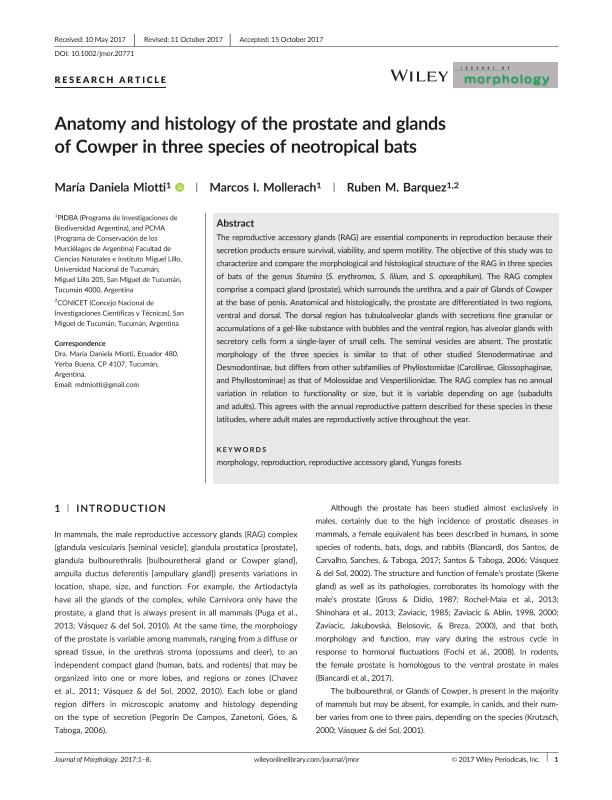Artículo
Anatomy and histology of the prostate and glands of Cowper in three species of neotropical bats
Fecha de publicación:
11/2017
Editorial:
Wiley-liss, Div John Wiley & Sons Inc
Revista:
Journal of Morphology
ISSN:
0362-2525
Idioma:
Inglés
Tipo de recurso:
Artículo publicado
Clasificación temática:
Resumen
The reproductive accessory glands (RAG) are essential components in reproduction because their secretion products ensure survival, viability, and sperm motility. The objective of this study was to characterize and compare the morphological and histological structure of the RAG in three species of bats of the genus Sturnira (S. erythromos, S. lilium, and S. oporaphilum). The RAG complex comprise a compact gland (prostate), which surrounds the urethra, and a pair of Glands of Cowper at the base of penis. Anatomical and histologically, the prostate are differentiated in two regions, ventral and dorsal. The dorsal region has tubuloalveolar glands with secretions fine granular or accumulations of a gel-like substance with bubbles and the ventral region, has alveolar glands with secretory cells form a single-layer of small cells. The seminal vesicles are absent. The prostatic morphology of the three species is similar to that of other studied Stenodermatinae and Desmodontinae, but differs from other subfamilies of Phyllostomidae (Carollinae, Glossophaginae, and Phyllostominae) as that of Molossidae and Vespertilionidae. The RAG complex has no annual variation in relation to functionality or size, but it is variable depending on age (subadults and adults). This agrees with the annual reproductive pattern described for these species in these latitudes, where adult males are reproductively active throughout the year.
Palabras clave:
Morphology
,
Reproduction
,
Reproductive Accessory Gland
,
Yungas Forests
Archivos asociados
Licencia
Identificadores
Colecciones
Articulos(CCT - NOA SUR)
Articulos de CTRO.CIENTIFICO TECNOL.CONICET - NOA SUR
Articulos de CTRO.CIENTIFICO TECNOL.CONICET - NOA SUR
Citación
Miotti, Maria Daniela; Mollerach, Marcos Ismale; Barquez, Ruben Marcos; Anatomy and histology of the prostate and glands of Cowper in three species of neotropical bats; Wiley-liss, Div John Wiley & Sons Inc; Journal of Morphology; 279; 3; 11-2017; 294-301
Compartir
Altmétricas




